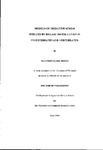MODELS OF OXIDATIVE STRESS INDUCED BY DISEASE OR POLLUTION IN INVERTEBRATES AND VERTEBRATES
| dc.contributor.author | MEIGH, HEATHER CLARE | |
| dc.contributor.other | School of Biological and Marine Sciences | en_US |
| dc.date.accessioned | 2013-10-28T09:35:05Z | |
| dc.date.available | 2013-10-28T09:35:05Z | |
| dc.date.issued | 2000 | |
| dc.identifier | NOT AVAILABLE | en_US |
| dc.identifier.uri | http://hdl.handle.net/10026.1/2393 | |
| dc.description.abstract |
Glutathione and its related enzymes have a central role in the antioxidant mechanisms of both invertebrates and vertebrates. Evidence suggests that changes in antioxidant defence mechanisms are associated with the late complications of diabetes. In addition, invertebrates show changes in antioxidant mechanisms in response to contamination; these changes have the potential to be utilised in the environmental monitoring of pollution. The present study investigated the role of glutathione and its related enzymes with regard to complications of diabetes and toxicity exposure using the crab, Carcinus maenas. A preliminary investigation showed that glutathione peroxidase and glutathione reductase activities are unaltered in the peripheral blood mononuclear cells from diabetic patients with long term complications of the disease. However, crabs were shown to have significantly reduced glutathione-s-transferase and glutathione peroxidase activities in response to cadmium exposure. The biochemical responses of crabs to pollution exposure were investigated in further experiments. Crabs are exposed to a variety of influences within their natural environment that may affect their ability to tolerate oxidative stress. These stressors include climatic changes, age, sex, nutritional status, contamination, accumulation of toxins and adaptation to a polluted environment. Results showed that seasonality also affects the activities of glutathione related enzymes glutathione reductase and glutathione-s-transferase, as well as physiological parameters such as tissue protein composition. Seasonal changes of enzyme activities may be partly due to the altered nutritional status of the crab over the year. Nutritional status also reduced the total glutathione status and total antioxidant scavenging ability of crab haemolymph and gill tissues. The levels of these parameters were reinstated to normal when the starved crabs were exposed to a mixed affluent. The ability to control the production of antioxidant scavenging compounds during fasting may help to preserve the crabs energy reserves. The promptly reinstated glutathione and total antioxidant scavenging ability in response to contamination helps to prevent the oxidative damage caused by pollution exposure. Several tissues were removed from the crab and the amount that each contributed to the crabs overall antioxidant scavenging ability was calculated. Haemolymph and muscle tissues were found to contribute the most to the crabs overall antioxidant scavenging ability. This is due to the large proportion of the crab that these tissues occupy. The level of glutathione within the crabs haemolymph, gill and muscle tissues did not contribute significantly to their overall antioxidant scavenging ability in normal conditions. However, when the stress was induced in the crabs in response to mixed effluent exposure or fasting, total glutathione levels became significantly correlated with total antioxidant scavenging ability. The results suggest that under these circumstances glutathione levels are maintained by the activity of glutathione reductase. A field trial was performed in the highly industrialised area of the Tees Estuary to establish whether the biomarkers that had been successfully applied in laboratory experiments could be used within the field. The results were analysed using multi-dimensional scaling techniques. This allowed a suite of biomarkers to be analysed simultaneously. The biomarker responses measured at the different sites indicated a gradient of toxicity from the top of the estuary to its mouth. These results were consistent with water chemical analysis data. The study showed that more information could be gained from this type of analysis than by examining the biomarker results separately. The biomarkers measured and the method of data analysis have potential to be used in routine toxicity assessment. | en_US |
| dc.language.iso | en | en_US |
| dc.publisher | University of Plymouth | en_US |
| dc.title | MODELS OF OXIDATIVE STRESS INDUCED BY DISEASE OR POLLUTION IN INVERTEBRATES AND VERTEBRATES | en_US |
| dc.type | Thesis | |
| dc.identifier.doi | http://dx.doi.org/10.24382/4402 | |
| dc.identifier.doi | http://dx.doi.org/10.24382/4402 |
Files in this item
This item appears in the following Collection(s)
-
01 Research Theses Main Collection
Research Theses Main


